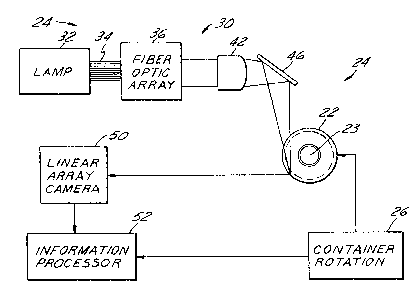Some of the information on this Web page has been provided by external sources. The Government of Canada is not responsible for the accuracy, reliability or currency of the information supplied by external sources. Users wishing to rely upon this information should consult directly with the source of the information. Content provided by external sources is not subject to official languages, privacy and accessibility requirements.
Any discrepancies in the text and image of the Claims and Abstract are due to differing posting times. Text of the Claims and Abstract are posted:
| (12) Patent: | (11) CA 2132111 |
|---|---|
| (54) English Title: | INSPECTION OF TRANSLUCENT CONTAINERS |
| (54) French Title: | INSPECTION DE CONTENANTS TRANSLUCIDES |
| Status: | Term Expired - Post Grant Beyond Limit |
| (51) International Patent Classification (IPC): |
|
|---|---|
| (72) Inventors : |
|
| (73) Owners : |
|
| (71) Applicants : |
|
| (74) Agent: | GOWLING WLG (CANADA) LLP |
| (74) Associate agent: | |
| (45) Issued: | 2003-11-18 |
| (22) Filed Date: | 1994-09-15 |
| (41) Open to Public Inspection: | 1995-03-17 |
| Examination requested: | 1999-09-29 |
| Availability of licence: | N/A |
| Dedicated to the Public: | N/A |
| (25) Language of filing: | English |
| Patent Cooperation Treaty (PCT): | No |
|---|
| (30) Application Priority Data: | ||||||
|---|---|---|---|---|---|---|
|
Apparatus for detecting checks in the sidewall of a translucent container (22) that includes a light source (24) for illuminating an elongated strip of the container sidewall parallel to the central axis of the container in such a way that illumination rays are incident at any point of the strip from multiple differing angles. A camera (50) is positioned externally of the container for receiving light reflected by checks in the illuminated strip, and electronic circuitry (52) is coupled to the camera for detecting checks in the container as a function of such reflected light. Since the light rays at any point in the elongated illuminated strip on the container sidewall are incident from multiple differing angles, planar checks and split seams in the container sidewall that are not precisely vertical in orientation will have a greater chance of reflecting light energy from the source onto the camera.
Appareil pour détecter des fissures dans la paroi latérale d'un contenant translucide (22) qui comprend une source de lumière (24) pour éclairer une partie allongée de la paroi latérale du contenant parallèlement à l'axe central du contenant de telle sorte que les rayons d'éclairage sont incidents à tout point de cette partie à partir de plusieurs angles différents. Une caméra (50) est positionnée à l'extérieur du contenant afin de recevoir la lumière réfléchie par les fissures situées dans la partie éclairée, et un circuit électronique (52) est couplé à la caméra pour détecter les fissures dans le contenant en fonction de cette lumière réfléchie. Les rayons lumineux en un point quelconque dans la partie lumineuse de la paroi latérale du contenant étant incidents à partir de plusieurs angles différents, les fissures planes et les soudures disjointes dans la paroi latérale du contenant qui ne sont pas précisément orientées verticalement auront une plus grande chance de réfléchir l'énergie lumineuse de la source sur la caméra.
Note: Claims are shown in the official language in which they were submitted.
Note: Descriptions are shown in the official language in which they were submitted.

2024-08-01:As part of the Next Generation Patents (NGP) transition, the Canadian Patents Database (CPD) now contains a more detailed Event History, which replicates the Event Log of our new back-office solution.
Please note that "Inactive:" events refers to events no longer in use in our new back-office solution.
For a clearer understanding of the status of the application/patent presented on this page, the site Disclaimer , as well as the definitions for Patent , Event History , Maintenance Fee and Payment History should be consulted.
| Description | Date |
|---|---|
| Inactive: Expired (new Act pat) | 2014-09-15 |
| Grant by Issuance | 2003-11-18 |
| Inactive: Cover page published | 2003-11-17 |
| Inactive: Final fee received | 2003-08-26 |
| Pre-grant | 2003-08-26 |
| Notice of Allowance is Issued | 2003-03-24 |
| Letter Sent | 2003-03-24 |
| Notice of Allowance is Issued | 2003-03-24 |
| Inactive: Approved for allowance (AFA) | 2003-03-12 |
| Amendment Received - Voluntary Amendment | 2003-01-28 |
| Inactive: S.30(2) Rules - Examiner requisition | 2002-07-30 |
| Amendment Received - Voluntary Amendment | 2000-03-02 |
| Inactive: Application prosecuted on TS as of Log entry date | 1999-11-30 |
| Letter Sent | 1999-11-30 |
| Inactive: Status info is complete as of Log entry date | 1999-11-30 |
| All Requirements for Examination Determined Compliant | 1999-09-29 |
| Request for Examination Requirements Determined Compliant | 1999-09-29 |
| Application Published (Open to Public Inspection) | 1995-03-17 |
There is no abandonment history.
The last payment was received on 2003-07-08
Note : If the full payment has not been received on or before the date indicated, a further fee may be required which may be one of the following
Patent fees are adjusted on the 1st of January every year. The amounts above are the current amounts if received by December 31 of the current year.
Please refer to the CIPO
Patent Fees
web page to see all current fee amounts.
Note: Records showing the ownership history in alphabetical order.
| Current Owners on Record |
|---|
| OWENS-BROCKWAY GLASS CONTAINER INC. |
| Past Owners on Record |
|---|
| JAMES A. RINGLIEN |
| TIMOTHY J. NICKS |